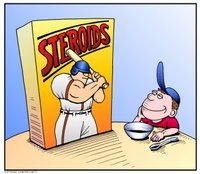Friday, July 28, 2006
Out-Landis Drug testing?

I think many of us were surprised and saddened to hear about the results of Floyd Landis’s drug test after his stunning Tour de France victory. I know I was. But I was also intrigued that he vehemently denied the results and demanded another test.
This got me curious, how do they test for doping in sports? And where is the gray area?
It seems there is no direct test for steroids; rather, tests are done to check for abnormally high levels of testosterone in relation to something known as epitestosterone. In the case of Landis, he did not show high testosterone levels, he simply showed a high ratio. It seems the average person has a 1:1 or maybe 2:1 ratio and Landis had more like a 9 or 10:1 ratio. However, epitestosterone has no adverse effects, and according to www.howstuffworks.com (http://entertainment.howstuffworks.com/athletic-drug-test6.htm) it would be ok for an athlete to inject him/herself with epitestosterone to lower the ratio and mask high levels of testosterone. Wouldn’t Landis have tried that if he had used steroids and believed he had something to hide?
An article appearing on slate (http://www.slate.com/id/2146630/?nav=tap3) by Brian Alexander notes that Landis could likely be innocent of doping, as the test does not actually detect steroids, but instead looks at the ratio between the proteins described above. If you ask me, Landis’s results merely look ‘suspicious’ and are nowhere near actual proof of doping.
Further, the slate piece asks, ‘if a test won’t stop doping, what will?’
Alexander points to the Italian model of anti-doping where athletes face criminal prosecution such as fines or prison time if found guilty. Would that ever happen in this country?
I think before we can consider tougher anti-doping laws we need to find a test for doping that will hold up in court.